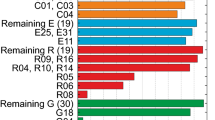Abstract
Different types of GPS clock and orbit data provided by the International GPS Service (IGS) have been used to assess the accuracy of rapid orbit determination for satellites in low Earth orbit (LEO) using spaceborne GPS measurements. To avoid the need for reference measurements from ground-based reference receivers, the analysis is based on an undifferenced processing of GPS code and carrier-phase measurements. Special attention is therefore given to the quality of GPS clock data that directly affects the resulting orbit determination accuracy. Interpolation of clock data from the available 15 min grid points is identified as a limiting factor in the use of IGS ultra-rapid ephemerides. Despite this restriction, a 10-cm orbit determination accuracy can be obtained with these products data as demonstrated for the GRACE-B spacecraft during selected data arcs between 2002 and 2004. This performance may be compared with a 5-cm orbit determination accuracy achievable with IGS rapid and final products using 5 min clock samples. For improved accuracy, high-rate (30 s) clock solutions are recommended that are presently only available from individual IGS centers. Likewise, a reduced latency and more frequent updates of IGS ultra-rapid ephemerides are desirable to meet the requirements of upcoming satellite missions for near real-time and precise orbit determination.





Similar content being viewed by others
References
AIUB; CODE 30 s clock solutions; URL ftp://ftp.unibe.ch/aiub/misc/products/HRRAPCLK; last accessed Nov. 2004
Bock H, Hugentobler U, Springer TA, Beutler G (2002) Efficient precise orbit determination of LEO satellites using GPS. Adv Space Res 30(2):295–300
Case K, Kruizinga G, Wu S (2002) GRACE level 1B data product user handbook. JPL Publication D-22027 Jet Propulsion Laboratory, Pasadena
DLR (2003) TerraSAR-X ground systems requirements; RD-RE-TerraSAR-DLR/02; Isue 2.0, 30 Sept. 2003; DLR, Bonn
Dunn C, Bertiger W, Bar-Sever Y, Bettadpur S, Desai S, Franklin G, Haines B, Kruizinga G, Kuang D, Meehan T, Nandi S, Nguyen D, Rogstad T, Romans L, Thomas J, Tien J, Watkins M, Wu S (2003) Instrument of Grace, GPS augments gravity measurements. GPS World 14(2):16–28
Eumetsat (2000) EPS mission statement of work: GRAS on metop precise orbit determination study; SOW EUM.EPS.SYS.SOW.004, Issue 4 March 2000
Fang P, Gendt G, Springer T, Manucci T (2001) IGS near real-time products and their applications. GPS Solutions 4(4):2
IGSCB (2004) IGS products; URL http://igscb.jpl.nasa.gov/components/prods.html; last updated 18 Jun. 2004
JPLRTG (2004) URL ftp://sideshow.jpl.nasa.gov/pub/15 min/; last accessed Nov. 2004
Kang Z, Nagel P, Pastor R (2003) Precise orbit determination for GRACE. Adv Space Res 31(8):1875–1881
König R, Zhu S, Reigber Ch, Neumayer K-H, Meixner H, Galas R, Baustert G, Schwintzer P (2003) CHAMP rapid orbit determination for GPS atmospheric limb sounding. Adv Space Res 30(2):289–293
Kouba J (2000) IGS orbit/clock navigation and sat. clock interpolations with no SA; IGSMAIL-2824; 5 May 2000; URL http://igscb.jpl.nasa.gov/mail/igsmail/2000/msg00163.html; last accessed Dec. 2002
Kouba J, Héroux P (2001) Precise point positioning using IGS orbit and clock products. GPS Solutions 5(2):12–28
Kouba J (2002) A guide to using international GPS service (IGS) products. URL http://igscb.jpl.nasa.gov/components/IGSProducts_user_v17.pdf; last accessed Nov 2004
Martínez-Fadrique FM, Luengo O (2001) METOP precise orbit determination in near real time with GPS. In: 16th international symposium on space flight dynamics, 6–10 December, Pasadena CA
McCarthy DD (1996) IERS conventions 1996; IERS Technical Note 21; Central Bureau of IERS - Observatoire de Paris; Paris
Montenbruck O, van Helleputte T, Kroes R, Gill E (2004) Reduced dynamic orbit determination using GPS code and carrier measurements. Aero Sci Technol (in press)
Muellerschoen RJ, Reichert A, Kuang D, Heflin M, Bertiger W, Bar-Sever Y (2001) Orbit determination with NASA’s high accuracy real-time global differential GPS system; ION-GPS-2001, 11–14 Sept 2001, Salt Lake City
PODAAC (2004) Physical Oceanography Distributed Active Archive Center–Gravity Recovery and Climate Experiment; URL http://podaac.jpl.nasa.gov/grace/; last accessed Oct 2004
Remondi BW (1991) NGS second generation ASCII and binary orbit formats and associated interpolation studies. In: Proceedings of the twentieth general assembly, International Union of Geodesy and Geophysics, August 11–24, 1991, Vienna, Austria
Rim H-Y, Yoon S-P, Schutz BE (2002) Effect of GPS orbit accuracy on CHAMP precise orbit determination; AAS 02–213; AAS/AIAA Space Flight Mechanics Meeting; 27–30 Jan, 2002; San Antonio, Texas
UT/CSR (2003) GRACE gravity model GGM01; Center for Space Research, University of Texas; Austin; URL http://www.csr.utexas.edu/grace/gravity/ggm01/GGM01_Notes.pdf; last accessed Oct. 2004
Van Helleputte T (2004) User manual for the GHOST orbit determination software; FDS-SUM-3110. Deutsches Zentrum für Luft- und Raumfahrt, Oberpfaffenhofen
Van den Ijssel J, Visser P, Patino Rodriguez (2003) CHAMP precise orbit determination using GPS data. Adv Space Res 31(8):1889–1895
Warren DLM, Raquet JF (2003) Broadcast vs. Precise GPS ephimerides: a historical perspective. GPS Solutions 7:151–156
Yunck TP (1996) Orbit determination. In: Parkinson BW, Spilker JJ (eds) Global positioning system: theory and applications. AIAA, Washington DC
Zumberge JF, Gendt G (2001) The demise of selective availability and implications for the international GPS service. Phys Chem Earth (A) 26(6–8):637–644
Acknowledgments
The present study makes use of GRACE GPS observations and reference orbits that have been made available by the Jet Propulsion Laboratory (JPL), Pasadena, on behalf of the GRACE project. GPS orbit and clock solutions have been obtained from the International GPS Service (IGS) and the Center for Orbit Determination in Europe (CODE). Selected samples of real-time generated GPS ephemerides have, furthermore, been provided by JPL for use in this analysis. The authors gratefully acknowledge these contributions.
Author information
Authors and Affiliations
Corresponding author
Rights and permissions
About this article
Cite this article
Montenbruck, O., Gill, E. & Kroes, R. Rapid orbit determination of LEO satellites using IGS clock and ephemeris products. GPS Solut 9, 226–235 (2005). https://doi.org/10.1007/s10291-005-0131-0
Received:
Accepted:
Published:
Issue Date:
DOI: https://doi.org/10.1007/s10291-005-0131-0




